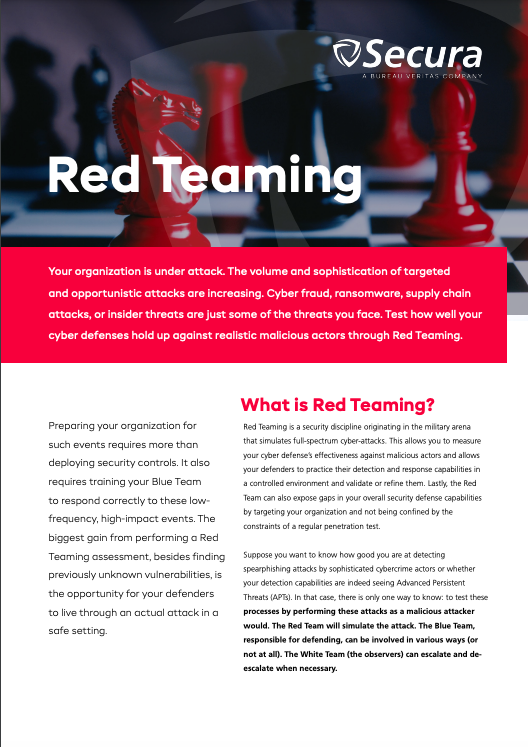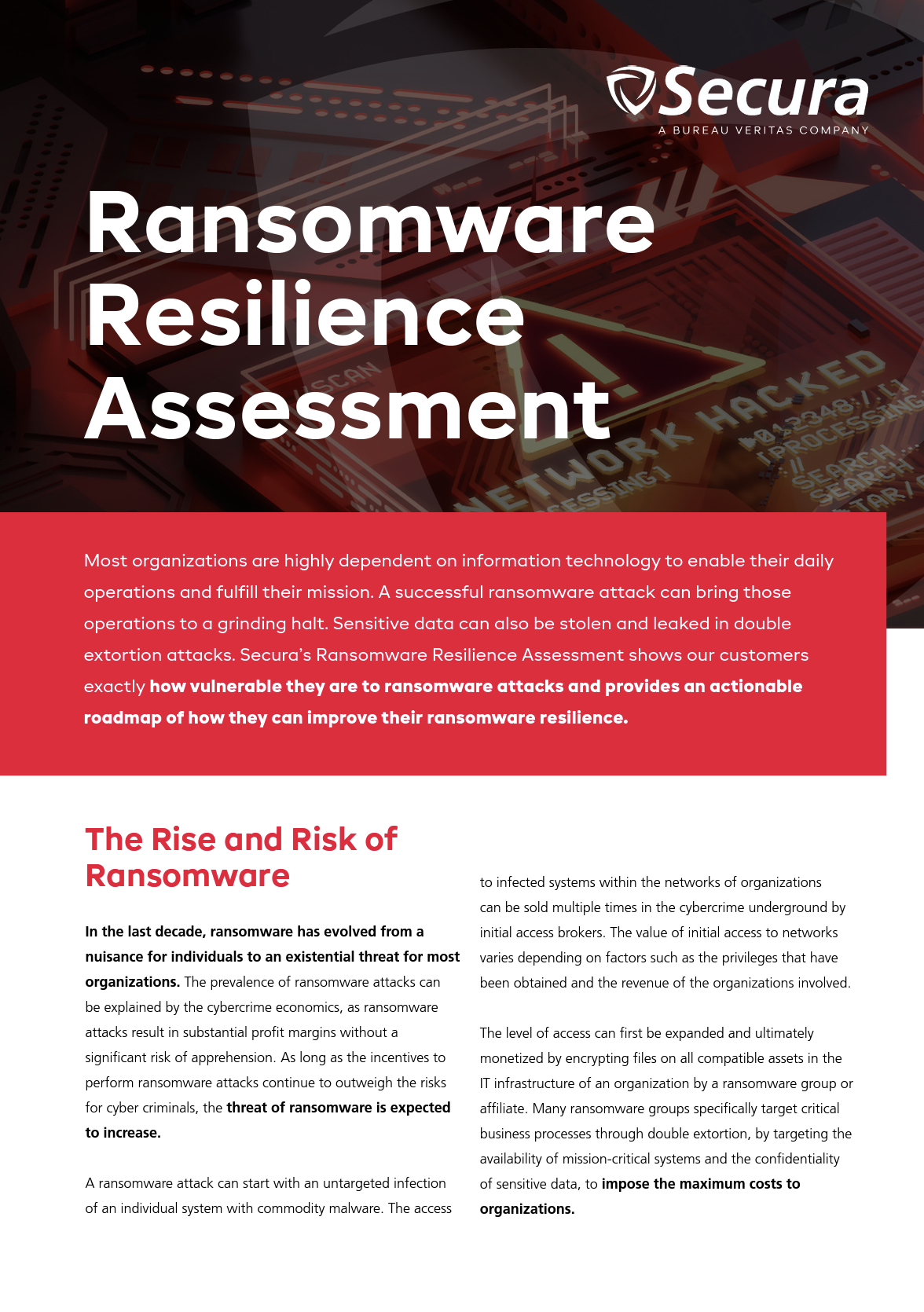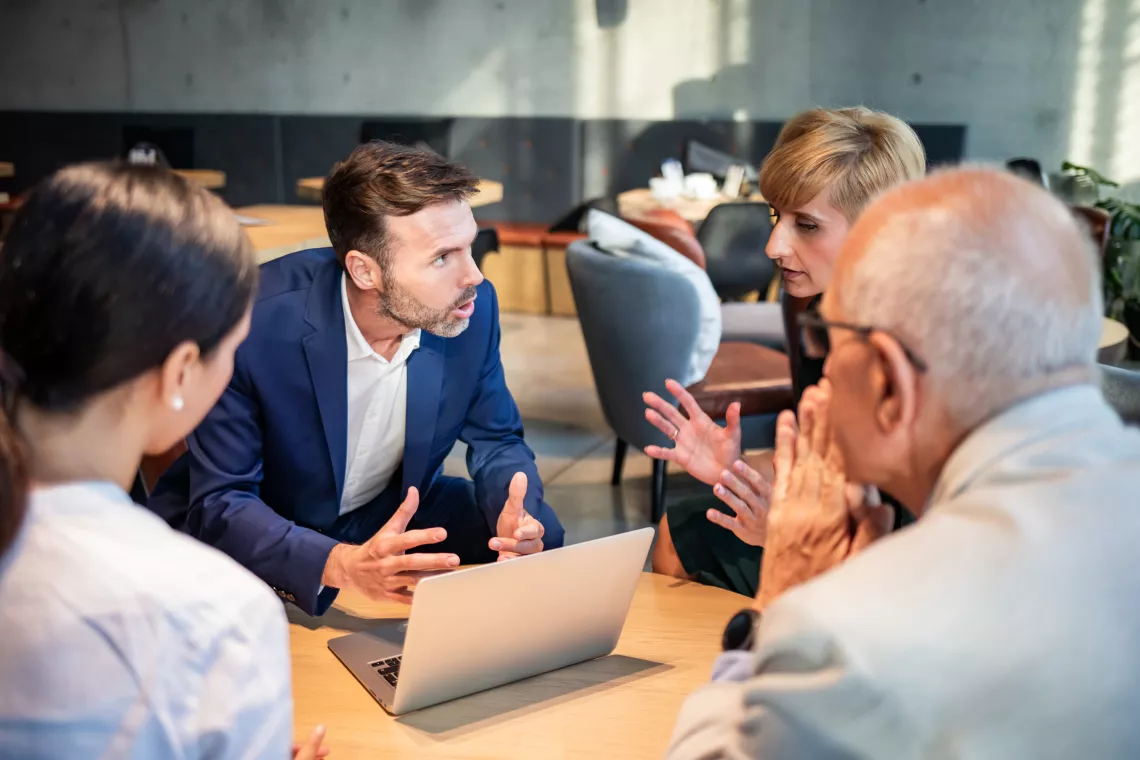Red Teaming
How well does your organization hold up against cyber threats, such as RANSOMWARE? Use Secura's Red Teaming and practice with a 'real' cyber attack.
> Services with an integrated approach > Red Teaming
Red Teaming - Practice with a real cyber attack
How well does your organization hold up against cyber threats, like ransomware, supply chain attacks, or insider fraud? Find out with Secura's Red Teaming assessment and raise your cyber resilience.

Watch the video about Red Teaming with Ben Brücker (2:00 min).

Simulate a real cyber attack

Train your team to detect & respond

Discover where to improve

YOUR CHALLENGES
- How to test the effectiveness of your cyber defense against realistic threats
- How to practice your team's detection and response capabilities in a controlled environment
- How to discover gaps in your cybersecurity defense capabilities, for example detecting spear phishing
Discover more about Red Teaming:
1. What is Red Teaming?
2. What are the benefits of Red Teaming?
3. Different types of Red Teaming
4. Steps in the Red Teaming Assessment
5. Red, Blue, White Team, and Purple Teams Explained
6. Secura's Red Team
What is Red Teaming?
Red Teaming is a security discipline originating in the military arena that simulates full-spectrum cyber-attacks. It's a way to test your cyber defense against bad actors. Red Teaming provides practice for your defense team, so they can refine their response capabilities in a controlled environment. Also, Red Teaming can expose security gaps. Unlike a regular penetration test, it targets your organization without constraints.
Suppose you want to know how good you are at detecting spear phishing attacks or Advanced Persistent Threats (APTs). In that case, there is only one way to find out: to test these processes by performing these attacks as a malicious attacker would.
The Red Team will simulate the attack. The Blue Team, responsible for defending, can be involved in various ways (or not at all). The White Team (the observers) can escalate and de-escalate when necessary.

Ben Brücker
Domain Manager Red Teaming | Senior Security Specialist
Secura
Being prepared for cyber attacks requires more than deploying security controls and procedures. You also have to train your team to respond correctly to these low-frequency, high-impact events.
Benefits of red teaming
Identification of Vulnerabilities: A Red Teaming Assessment helps identify both technical and non-technical vulnerabilities in your system that less comprehensive assessments might miss.
Testing Incident Response: Red Teaming allows an organization to test its incident response procedures. When the Red Team launches their simulated attack, the Blue Team (internal security team) will attempt to detect and respond to it. This can help reveal issues with incident response plans, such as slow detection times or poor communication between teams.
Provides Realistic Threat Scenarios: Unlike traditional penetration testing, which typically focuses on a specific aspect of a system, Red Teaming provides a full-spectrum threat scenario that can emulate advanced persistent threats. This can provide an organization with a more realistic understanding of its security posture and the
Types of Red Teaming
Red Teaming is gaining popularity in all sectors, from financials to public organizations and even (critical) industry as a security discipline. We offer different types of Red Teaming, to meet the needs and budget of your organization. All assessments use the MITRE ATT&CK framework and offer the opportunity to work in a Purple Teaming setup (a combined effort between Red and Blue).
1. Red Teaming Modular
Are you up for the next step after pentesting? Red Teaming Modular offers the chance to select the most relevant attacks for your organization.
2. Red Teaming Core
Red Teaming Core is a full-blown attack simulation for medium to large businesses that employ their own Blue Teams. This type will condense extensive threat landscape analysis. The attack scenarios are based on real-world threats, using .Techniques, Tactics, and Procedures (TTP’s) defined in the MITRE ATT&CK Framework.
3. Red Teaming Pro
The Pro variant of Red Teaming is a step up for organizations with very mature Blue Teams and a high level of cyber resilience. Attacking a mature organization such as yours requires much more effort by the Red Team to, for example, deploy malware that bypasses your EDR solution. Here the Red Team works as a completely independent group, and Leg Up scenarios are only used as a last resort. The Red Teaming Pro is the most realistic simulation of attacks by Advanced Persistent Threats (APTs) against your organization.
4. Advanced Red Teaming
Advanced Red Teaming is a framework for threat intelligence based red teaming, developed by De Nederlandsche Bank. Advanced Red Teaming gives you strategic insight into your resilience against real world treat actors. It tests your defensive capabilities in depth. Do you want to conduct an Advanced Red Teaming project? Our experienced Red Teaming experts can help you.
Read more about Advanced Red Teaming here.
5. Red Teaming in OT
Similar to our Red Teaming Pro service, but specifically focused on generating a low volume and simulated high impact events on your ICS and SCADA control systems. Attackers targeting these environments use different tactics, resulting in a tailor-made process that mitigates any operational environment risks.
Read more about Red Teaming in OT here
6. TIBER
TIBER - Threat Intelligence Based Ethical Red Teaming - is part of the financial sector's effort to improve cyber resilience under the guidance of the Dutch National Bank. Secura is capable of functioning as Red Teaming Provider (RTP), complying with the requirements in the TIBER-NL guidelines.
Secura’s experience in Red Teaming, combined with our capabilities, passion, and TIBER-specific experience, provides our customers with the best possible basis for the clean, solid execution and management of TIBER engagements. Read more: TIBER Fact Sheet
7. ZORRO
ZORRO - Zorg Red Teaming Resilience Exercises - developed by Z-CERT, aims to improve the cyber resilience of healthcare providers. Secura offers a cost-effective testing program that meets the requirements of the ZORRO methodology.
8. Tabletop Cyber Crisis Management
Secura confronts your crisis management team with a challenging but realistic cyber threat incident to test cooperation and coordination. During a one-day Tabletop Cyber Crisis Management Workshop, your team will be presented with so-called injects, providing a realistic feel in a simulated and controlled environment. Such a tabletop session is beneficial for developing your cyber crisis management skills and preparing the team for other high-impact incidents.
The Process of Red Teaming
01
Phase 1 - Planning and Preparation
Managing the process starts with planning and careful preparation. A dedicated project manager works together with the Red Team lead and the White Team to create a schedule and a dedicated set of rules of engagement. Throughout the engagement, this schedule is followed and adjusted where necessary. Risks and scenarios are assessed continually. The Red Team will constantly communicate with the White Team via weekly scheduled meetings, a secure chat group, and additional calls where necessary. This ensures that the White Team is in full control of the attack.
02
Phase 2 - The Attack
After careful consideration and planning, our consultants will go on the attack and attempt to access your so-called ‘crown jewels’ in any way possible. Depending on the target, Secura will use a mixture of offensive social engineering and computer network attack techniques as a real-world malicious actor would. Techniques used are mystery guest, phishing, vishing, attacks from the internet, and computer networking attacks in your internal networks.
03
Phase 3 - Clean Closure
Once the attack is over, the so-called clean closure stage begins. This stage does not only mean managing the leftover digital remnants of the executed attacks. It also means providing the Blue Team with one or more evaluation sessions where the complete timeline is replayed in a workshop, maximizing learning and awareness. The end result of this phase is a detailed technical report and a perspective on your overall security maturity in your threat landscape

Webinar Replay | Red Teaming in OT @Enexis
Dealing with real world attack scenarios requires more than a dedicated Security Operations Center (SOC); it requires hands-on training and learning by doing. Find the weak spots before real attackers do. Red Teaming in the Operational Technology domain is significantly different from traditional Red Teaming against traditional enterprises. Watch the replay of our latest webinar.
Red, blue, white and purple teams explained
Red Team
Secura's Red Team assumes the role of a hostile attacker. Ideally, only a few people in your organization are aware of the Red Teaming assessment. In that way, the authenticity of this digital fire exercise is optimal.
Blue Team
Your organization's Blue Team is responsible for defending the networks, systems, and applications. This team is generally unaware of the Red Teaming simulation, to increase realism and test response.
White Team
The White Team acts as the link between the Red and Blue Teams. It consists of employees from your organization and from Secura. The White team is informed about all attacks, and is mandated to start, stop and approve attacks.
Purple Team
In some cases, the Blue Team finds out about the Red Teaming Assessment. In that situation, it might be better to inform the Blue Team and work together. This is called Purple Teaming.
Secura's Red Team
An attacker uses a vast arsenal of tools to abuse all aspects of your digital security, technology, physical security, and human behavior to access your most important crown jewels. To mimic this type of attack requires a team of experienced hackers and social engineers with the proper knowledge, broad experience, and many specialties. Secura has built this knowledge, experience, and specialties into its team over the past twenty years. Therefore, our multidisciplinary team consists of top specialists with knowledge and experience in the three security domains: technology, physical security, and human behavior.
Our Red Teamers hold relevant certifications such as Certified Red Team Professional (CRTP), Certified Red Team Operator (CRTO), Certified Red Team Expert (CRTE), Master Level Social Engineer (MLSE), and many others.
Secura's experience in red teaming, combined with our capabilities, passion, and industry-specific experience, provides our clients with the best possible foundation for clean, solid execution and management of Red Teaming engagements.
DOWNLOAD FACT SHEETS

Secura Red Teaming Fact Sheet
What is Red Teaming? What are the different teams and types of red teaming?
Download

Contact me about red teaming
Would you like to learn more about our Red Teaming Assessment? Please fill out the form below, and we will contact you within one business day.

Related Services
Tabletop Cyber Crisis Management
Social Engineering Awareness
Hacker Mindset Workshop
Secura CyberCare
Ransomware Resilience Assessment
Why choose Secura | Bureau Veritas
At Secura/Bureau Veritas, we are dedicated to being your trusted partner in cybersecurity. We go beyond quick fixes and isolated services. Our integrated approach makes sure that every aspect of your company or organization is cyber resilient, from your technology to your processes and your people.
Secura is the cybersecurity division of Bureau Veritas, specialized in testing, inspection and certification. Bureau Veritas was founded in 1828, has over 80.000 employees and is active in 140 countries.

















